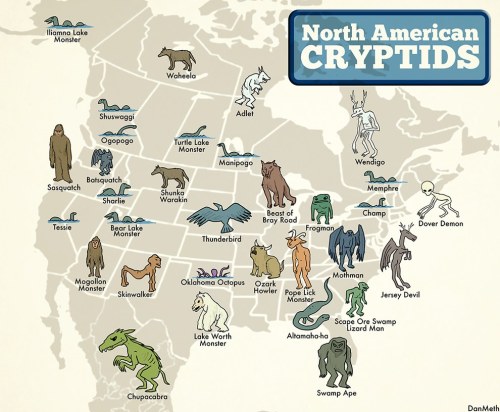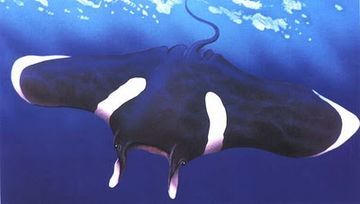Convergent Evolution: Dasyuromorphia And Carnivora


Convergent evolution: Dasyuromorphia and Carnivora
The Encyclopedia of Animal Evolution, 1987
More Posts from Jackasslope and Others

A newly discovered photograph of a captive thylacine at Beaumaris Zoo c.1913, found in a private collection in the U.K. by thylacine enthusiast Alan Pringle.
The photo was one of three purchased at Salamanca Market in Hobart over 20 years ago. [x]
This thylacine footage was recently rediscovered by researchers Gareth Linnard, Branden Holmes and Mike Williams on March 4, 2020.
Originally filmed by the Bester family c. 1933-1936, the 9.5mm black and white film includes 7 seconds of a captive thylacine in its enclosure at the Beaumaris Zoo.
Such a rare and amazing find!


Kelpie
Powerful shapeshifting equine, lure people into the water, usually in the form of a horse or a beautiful young woman, in order to drown them and feast on their corpses.


The door of the Holy Trinity Church in Blythburgh, England, boasts the proposed claw marks of Black Shuck. On August 4th, 1577, the Hellhound burst through the door of the church during a thunderstorm, interrupting the congregation in their meeting. Records state that two people, a man and a boy, were killed by the beast and the steeple of the church collapsed. The marks were made when Black Shuck left the church after the attack.


Beebe’s Manta Ray was first reported by William Beebe nearby the Galapagos Islands on April 27th, 1923. He described the manta as having a 10 foot wingspan. Its back is a dark brown with distinctive white bands that go halfway down its back to either side of its head. The very tips of the wings are also white in color. The manta supposedly collided with Beebe’s vessel briefly before quickly retreating from it.
-
 noemiawild-79 reblogged this · 1 month ago
noemiawild-79 reblogged this · 1 month ago -
 noemiawild-79 liked this · 1 month ago
noemiawild-79 liked this · 1 month ago -
 tugalino liked this · 2 years ago
tugalino liked this · 2 years ago -
 zebrashork liked this · 2 years ago
zebrashork liked this · 2 years ago -
 eclecticblazeruins liked this · 3 years ago
eclecticblazeruins liked this · 3 years ago -
 ashes-to-asher liked this · 3 years ago
ashes-to-asher liked this · 3 years ago -
 orox-art liked this · 3 years ago
orox-art liked this · 3 years ago -
 wynterwulf7 liked this · 3 years ago
wynterwulf7 liked this · 3 years ago -
 attemptedscribblez liked this · 3 years ago
attemptedscribblez liked this · 3 years ago -
 dr-w0rm liked this · 3 years ago
dr-w0rm liked this · 3 years ago -
 coniferx reblogged this · 3 years ago
coniferx reblogged this · 3 years ago -
 skyhawkingg liked this · 3 years ago
skyhawkingg liked this · 3 years ago -
 wolverineteethhh-movedaccounts liked this · 3 years ago
wolverineteethhh-movedaccounts liked this · 3 years ago -
 of-wolves-dragons-and-leopards liked this · 3 years ago
of-wolves-dragons-and-leopards liked this · 3 years ago -
 sunscribble305409 reblogged this · 3 years ago
sunscribble305409 reblogged this · 3 years ago -
 jessymetal liked this · 4 years ago
jessymetal liked this · 4 years ago -
 gennethapang reblogged this · 4 years ago
gennethapang reblogged this · 4 years ago -
 silenthole reblogged this · 4 years ago
silenthole reblogged this · 4 years ago -
 snackthat-smilesback reblogged this · 4 years ago
snackthat-smilesback reblogged this · 4 years ago -
 snackthat-smilesback liked this · 4 years ago
snackthat-smilesback liked this · 4 years ago -
 moss-flowers-trees liked this · 4 years ago
moss-flowers-trees liked this · 4 years ago -
 rosefinchs reblogged this · 4 years ago
rosefinchs reblogged this · 4 years ago -
 see-the-trees-enjoy-the-forest reblogged this · 4 years ago
see-the-trees-enjoy-the-forest reblogged this · 4 years ago -
 see-the-trees-enjoy-the-forest liked this · 4 years ago
see-the-trees-enjoy-the-forest liked this · 4 years ago -
 fliztastic reblogged this · 4 years ago
fliztastic reblogged this · 4 years ago -
 fliztastic liked this · 4 years ago
fliztastic liked this · 4 years ago -
 pajaritocantando liked this · 4 years ago
pajaritocantando liked this · 4 years ago -
 mamma-mercy liked this · 4 years ago
mamma-mercy liked this · 4 years ago -
 missingrectrix liked this · 4 years ago
missingrectrix liked this · 4 years ago -
 kynawrath reblogged this · 4 years ago
kynawrath reblogged this · 4 years ago -
 kynawrath liked this · 4 years ago
kynawrath liked this · 4 years ago -
 flightspecialists liked this · 4 years ago
flightspecialists liked this · 4 years ago -
 pineapplesharks reblogged this · 4 years ago
pineapplesharks reblogged this · 4 years ago -
 pineapplesharks liked this · 4 years ago
pineapplesharks liked this · 4 years ago -
 parrot-parent liked this · 4 years ago
parrot-parent liked this · 4 years ago -
 luciferin-s reblogged this · 4 years ago
luciferin-s reblogged this · 4 years ago -
 cooldogsquad reblogged this · 4 years ago
cooldogsquad reblogged this · 4 years ago -
 cooldogsquad liked this · 4 years ago
cooldogsquad liked this · 4 years ago -
 enby-newt reblogged this · 4 years ago
enby-newt reblogged this · 4 years ago -
 velvetmel0n liked this · 4 years ago
velvetmel0n liked this · 4 years ago -
 xaidread reblogged this · 4 years ago
xaidread reblogged this · 4 years ago -
 redefine2d reblogged this · 4 years ago
redefine2d reblogged this · 4 years ago -
 thingsfoxeseat reblogged this · 4 years ago
thingsfoxeseat reblogged this · 4 years ago -
 werewoofs liked this · 4 years ago
werewoofs liked this · 4 years ago -
 colubridkid liked this · 4 years ago
colubridkid liked this · 4 years ago -
 sourthesour liked this · 4 years ago
sourthesour liked this · 4 years ago -
 gremlin-pattie liked this · 4 years ago
gremlin-pattie liked this · 4 years ago

![“Driftwood Thylacine” By Fiona Francois, Done In Pencil And Charcoal. [x]](https://64.media.tumblr.com/832d1ffbafedf0082617417fd52565c7/c41cd29197cd9f38-f3/s500x750/78ae0f057b573b6631ae33e5fe8ecfcae6ec4f2a.jpg)

